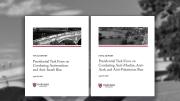Until recently, teenage violence was widely considered a deplorable and tragic phenomenon of inner cities. Experts linked childhood aggression to certain demographic or socioeconomic factors such as class, race, and gender. But a new study indicates that demographics and socioeconomics are much weaker predictors of future aggression than two other factors. Physical punishment by parents, and inhibited temperament (a personality trait often confused with shyness, but characterized by a measurable physiological response to novel situations), are in fact the strongest predictors of aggression in teens.
This longitudinal study, led by Bigelow professor of education Kurt Fischer and funded by the National Institute of Child Health and Human Development, tracked 440 children (aged between 7 and 13 at the start of the study) for eight years to trace the antecedents of teenage aggression, which researchers defined as ranging from hostile behavior to physical violence. The representative sample from Springfield, Massachusetts, included approximately equal numbers of white, African-American, and Latino boys and girls at all socioeconomic levels. Each year, researchers assessed inhibited temperament and aggression, along with other behaviors, using at-home interviews as well as standardized questionnaires and tests.
The study's finding that a child with abusive parents is more likely to act aggressively seems logical enough. What was unexpected was the study's evidence of the decisive role of inhibited temperamentoften associated with withdrawn or disengaged childrenas an antecedent of aggression. That this previously underestimated factor could predict future aggression more powerfully than race, ethnicity, class, or gender was remarkable even to experts. "This is one of the most exciting findings," says Fischer. Indeed, only one demographic factoragepredicted aggression well: as certain kids get older, they also get more violent.
Inhibited temperament is a personality trait identifiable in infants who are placed in novel situations. Inhibited babies "tend to tense up; to become awkward; to fret," Fischer explains. They may react more violently than uninhibited babies (for example, by crying and kicking) to unpleasant noises or new faces.
Inhibited temperament has been studied extensively by Starch research professor of psychology Jerome Kagan. "It has been showing up in research for decades," Fischer says. Parents and teachers frequentlyand often incorrectlylabel such behavior as "shyness." Shyness, however, is a broad, vague term: "Everybody shows shy behavior sometimes," Fischer says. Unlike shyness, inhibited temperament has measurable and acute physiological effects. "When we measure [these infants'] heart rates and brain functions [during new situations], they show a high emotional reactivity," Fischer explains. "They don't just withdraw."
The Springfield researchers assessed inhibited temperament in one-and-a-half- to two-hour-long separate interviews with child and mother. Participants also completed standardized questionnaires, such as the Achenbach Child Behavior Checklist (CBCL). Administered separately to mother and child, the CBCL poses more than 100 straightforward questions such as, "How many close friends does your child have?" and "Does your child like to try new things?" Children were also encouraged to tell stories or draw pictures. "We might ask how a child encounters new kids," says Fischer. "Is he or she slow to play with them?"
Similar methods were used to measure parental punishment and childhood aggression. Mothers took the Straus Conflict Tactics Scale, a set of questions concerning discipline methods, for example: "[Have you] hit with a fist or kicked hard?" and "[Have you] grabbed around the neck and choked?" "People are surprisingly honest in this questionnaire," says Fischer. In interviews about discipline, children "reported a wide range of aggressive acts by their parents. There was good correspondence between parental and child reports."
The researchers also queried children about their own violent behavior. For example, the CBCL asks how often a child teases, threatens, or physically attacks other people. Additionally, interviewers asked, "Have you been in any fights recently? Have you been beaten up?" Mothers answered similar questions about their children.
The study's findings support a connection between inhibited temperament and the teenage perpetrators of high-profile school attacks. The young gunmen at Columbine High School were known as isolated and alienated youths. "They were picked on a lot. They were uncool," says Fischer. He urges schools to step in when students appear withdrawn and "encourage them to connect to the community, to establish friendships." Despite its appearance in infancy, inhibited temperament is not immutable. "An awful lot goes on in early adolescence, and kids can make major changes," Fischer says. "Don't give up on a kid just because he's nine and already aggressive."






